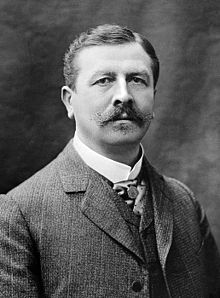Joseph Babinski
Joseph Jules François Félix Babinski (born November 17, 1857 in Paris , France , † October 29, 1932 ibid), also Józef Julian Franciszek Feliks Babiński in Polish , was an important French neurologist .
Life
Babinski was born the son of former Polish refugees. His father, an engineer, and his mother fled Warsaw to Paris in 1848 . His brother was the engineer and cookbook author Henri Babinski . Joseph Babinski first studied medicine in Paris and then specialized in neurology . During his studies Jean-Martin Charcot became aware of the young Babinski and he soon became his favorite student. Babinski earned his doctorate in 1885 at the University of Paris with a paper on multiple sclerosis , a topic suggested to him by Alfred Vulpian (1826-1887).
Another student of Charcot, Charles-Joseph Bouchard, was decisive for the further life of Babinski . He soon received a professorship and fell out with his mentor. By Bouchard's intrigues in 1892 Babinski was denied an academic career as a professor. Therefore, in 1890 he went to Charcot at the great Hôpital de la Salpêtrière in Paris. That was a godsend for French neurology. Free from teaching tasks, he devoted himself to the symptomatology of neurological diseases and wrote a total of 288 publications. In 1895 Babinski became director of the Hôpital de la Pitié in Paris and headed it until 1922.
Babinski sign
In 1896, at a conference of the Société de Biologie , Babinski presented the background to a pathological reflex that Vulpian and Ernst Julius Remak had previously described. Babinski realized that injuries to the pyramidal orbit were the cause. By 1903 he published several extensive works on the subject. The phenomenon is now known as the Babinski reflex or Babinski's sign .
Influence on neurosurgery
End of the 19th century, the first were laminectomies and operations to remove tumors of the spinal cord performed. Babinski had referred some patients to the greats in this field at the time, but was dissatisfied with the results. He suspected that the operations were being performed on the wrong vertebral segment, namely too deep. He teamed up with Thierry de Martel (1875–1940) and had his next patient operated on by him. Due to Babinski's exact prediction of the location, Thierry de Martel was able to successfully remove the tumor, which is seen as the rebirth of French neurosurgery.
Further work on neurology
In 1900, a year before Alfred Fröhlich , Babinski described the dystrophia adiposogenitalis in a tumor of the pituitary gland , now also known as the Fröhlich syndrome or Babinski-Fröhlich syndrome . In 1902, together with Jean Nageotte (1866–1948), he described the clinical symptoms of an ischemic failure of the postero-lateral part of the medulla oblongata , now also known as Babinski-Nageotte syndrome . In 1905 he described the neurophysiological background of the tabes dorsalis . He dealt with the pathology of the cerebellum and introduced the terms ataxia and dysdiadochokinesis as the leading symptoms of cerebellar lesions.
Furthermore, Babinski dealt with the pathogenesis of hysteria and for the first time worked out reliable differential diagnostic criteria in order to distinguish it from organic diseases. He refuted the thesis of his teacher Charcot , who believed he had discovered a new disease, "hysteroepilepsy".
In the last years of his life, Babinski suffered from Parkinson's disease .
literature
- Jacques Philppon, Jacques Poirier: Joseph Babinski: A Biography. Oxford University Press, New York 2009, ISBN 978-0-19-536975-5 .
- Barbara I. Tshisuaka: Babinsky, Joseph François Felix. In: Werner E. Gerabek , Bernhard D. Haage, Gundolf Keil , Wolfgang Wegner (eds.): Enzyklopädie Medizingeschichte. De Gruyter, Berlin / New York 2005, ISBN 3-11-015714-4 , p. 128.
Web links
| personal data | |
|---|---|
| SURNAME | Babinski, Joseph |
| ALTERNATIVE NAMES | Babinski, Joseph Jules François Félix (full name); Babiński, Józef Julian Franciszek Feliks |
| BRIEF DESCRIPTION | Polish-French neurologist |
| DATE OF BIRTH | November 17, 1857 |
| PLACE OF BIRTH | Paris |
| DATE OF DEATH | October 29, 1932 |
| Place of death | Paris |
